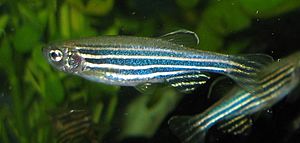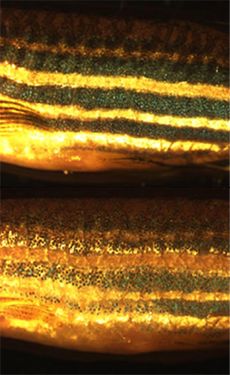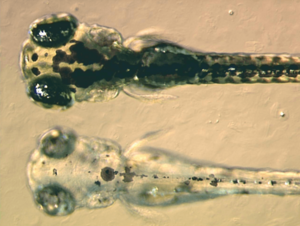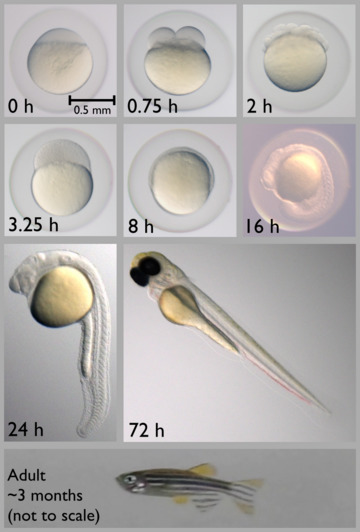Zebrafish facts for kids
Quick facts for kids Danio rerio |
|
|---|---|
 |
|
| An adult female zebrafish | |
| Conservation status | |
| Scientific classification | |
| Synonyms | |
|
The zebrafish (Danio rerio) is a small freshwater fish. It belongs to the minnow family called Cyprinidae. These fish are originally from India and other parts of South Asia.
Zebrafish are very popular aquarium fish. People often call them "zebra danios." They are also important for science. Scientists use them a lot in research, especially to study how living things develop and how diseases work. Zebrafish are amazing because they can regrow some body parts! Scientists have also made special zebrafish that glow.
Where do zebrafish live?
Natural homes
Zebrafish live in fresh water in South Asia. You can find them in countries like India, Pakistan, Bangladesh, Nepal, and Bhutan. They mostly live in the areas around the Ganges and Brahmaputra Rivers.
Sometimes, people have also brought zebrafish to other places. They have been seen in parts of the United States, like California and Florida. This usually happens when fish escape from fish farms or when people let their pet fish go into the wild.
What their homes are like
Zebrafish like clear water that moves slowly or stays still. They live in shallow places like streams, canals, ditches, ponds, and even rice paddies. These spots often have plants growing in or near the water. The bottom of their homes can be sandy, muddy, or have small rocks.
The water where zebrafish live is usually a bit warm. It can be anywhere from about 16.5 to 34 degrees Celsius (62 to 93 degrees Fahrenheit). They are very tough fish and can even survive in slightly colder or warmer water.
What do zebrafish look like?
Zebrafish get their name from the five blue stripes on their sides. These stripes look a lot like a zebra's stripes! The stripes go all the way to their tail fin. Their body is shaped like a torpedo and is a bit flat on the sides. Their mouth points upwards.
Male zebrafish are usually thinner and have gold stripes between the blue ones. Female zebrafish have a bigger, whitish belly and silver stripes. Zebrafish can grow to be about 4 to 5 centimeters (1.6 to 2 inches) long. In the wild, they are usually a bit smaller. They can live for two to three years in a tank, and sometimes even longer.
How do zebrafish think?
Scientists have studied how zebrafish think and remember things. In 2015, a study showed that zebrafish can remember specific events. This means they can remember "what" happened, "when" it happened, and "where" it happened. This type of memory is called episodic memory. It's similar to how humans remember past experiences.
Zebrafish also have a special way to escape danger very quickly. They have special cells that help them react fast to things like sudden movements or shadows that look like a predator.
Reproduction and life cycle
Zebrafish grow up very quickly. They can start having babies when they are about three months old. Female zebrafish can lay hundreds of eggs every two or three days if conditions are good.
When the eggs are laid, they are almost see-through. This makes them great for scientists to study how baby fish develop. The baby fish grow very fast inside the egg.
- At 0 hours, the egg has a large yolk with one big cell on top.
- By 0.75 hours, that cell has divided into two.
- By 3.25 hours, there are thousands of tiny cells.
- At 8 hours, the cells start moving down the yolk and forming a head and tail.
- By 16 hours, the head and tail are clearer.
- At 24 hours, the tail grows and separates from the body.
- The yolk gets smaller over time because the baby fish uses it for food.
- After a few months, the fish is an adult and can have its own babies.
To help zebrafish lay eggs, scientists sometimes use special tanks. Zebrafish usually lay their eggs in the morning. A single pair of zebrafish can lay 200 to 300 eggs in one morning! Male zebrafish seem to like females with strong, clear stripes. Having plants in the tank, even plastic ones, also helps encourage them to lay eggs.
What do zebrafish eat?
Zebrafish are omnivorous, which means they eat both plants and animals. They mostly eat tiny animals called zooplankton and tiny plants called phytoplankton. They also enjoy eating insects and their young (larvae). If their favorite foods are not around, they can eat other things like worms or small crustaceans.
In science labs, adult zebrafish are often fed with tiny shrimp called brine shrimp.
Zebrafish as pets
Zebrafish are good pets for people who are new to keeping fish. They are tough fish and easy to care for. People love them because they are playful, breed quickly, don't cost much, and are easy to find. They like to live in groups of six or more fish and usually get along well with other types of fish in an aquarium.
However, zebrafish can get sick. They are sometimes affected by diseases like velvet disease or certain types of bacteria. Adult zebrafish might eat their own babies. To protect the baby fish, you can separate them from the adults using a net or a different tank. In a tank, zebrafish usually live for about three and a half years.
Some zebrafish have been changed by scientists to glow in different colors. These are called GloFish and were the first type of glowing fish sold as pets.
Different types of zebrafish
In the early 2000s, scientists made glowing zebrafish. These fish have special genes that make them glow green, red, or yellow under certain lights. These glowing fish are sold under the name GloFish.
There are also other types of zebrafish that people have bred for aquariums. These include "golden" zebrafish, "sandy" ones, and "longfin" zebrafish with longer fins. The "leopard danio" is a spotted version of the zebrafish. It has spots instead of stripes because of a natural change in its color.
Scientists keep many different types of zebrafish for research. These include both natural and specially modified kinds.
Why are zebrafish important for science?


Zebrafish are very useful for scientific studies, especially for understanding how vertebrate animals (animals with backbones) develop and how genes work. A scientist named George Streisinger started using zebrafish for research in the 1970s and 1980s. His zebrafish were some of the first animals with backbones to be successfully cloned.
There is a special online database called the Zebrafish Information Network (ZFIN) that has lots of information about zebrafish genes and development. There's also a center that stores different types of zebrafish for scientists to use. Zebrafish are even one of the few fish that have traveled into space for experiments!
Research with zebrafish has helped us learn more about many important topics, such as:
- How living things grow and develop.
- How to find new medicines.
- How the brain and nerves work.
- How to grow new cells for medicine.
- How to understand and treat muscle diseases.
See also
- Japanese rice fish or medaka, another fish used for genetic, developmental, and biomedical research
- List of freshwater aquarium fish species
- Denison barb
 In Spanish: Pez cebra para niños
In Spanish: Pez cebra para niños



